
The Victor-Victrola Page

VTLA / VV XVI / VE-XVI / VV-XX
Pooley Version ("VTLA" tag, flat lid):
RARITY: ¤¤¤ VALUE:
¤¤¤
VTLA Version ("VTLA" tag, domed lid): RARITY:
¤¤ VALUE: ¤¤¤
VV-XX Version ("VTLA" tag, domed lid, fancy trim,
diagonal grain patterns on front doors): RARITY:
¤¤¤¤ VALUE: ¤¤¤¤
Vernis-Martin Version (gold painted cabinet with
figures): RARITY: ¤¤¤¤
VALUE: ¤¤¤¤
VV-XVI or VE-XVI (with L-shaped doors):
RARITY: ¤¤ VALUE:
¤¤
VV-XVI or VE-XVI (with conventional doors):
RARITY: ¤ VALUE:
¤

The VV-XVI or
"Victrola the Sixteenth" was
the original internal-horn Victrola; introduced in 1906, it remained the
company's premiere model for nearly 15 years. The XVI created a sensation when
it first appeared at dealer showrooms, as the ungainly phonograph horn was now
hidden inside the cabinet rather than being mounted on top
of the machine. "Tone Doors" in the front allowed the user to control the sound
volume, and the lid could be closed to lower the noise emanating from the vibrating soundbox and motor. Storage for record albums was
provided in the bottom portion of the cabinet. Priced at a whopping $200.00
(which equates to over $5,700.00 in today's money), it was intended for wealthy
buyers who desired a 'state of the art' phonograph integrated into an elegant
piece of furniture.
The XVI cabinet underwent
several design iterations during its lifespan; by the early 'teens, it became a top-seller for
the company. Although it was always advertised as "Victrola the Sixteenth"
(VV-XVI), the metal identification tag used a "VTLA" designation during the early
years of production. More than 206,000 XVI/VTLA/XX machines were produced
between 1906 and 1921.
The internal horn design configuration was soon adopted by numerous lower-cost Victrola models; when Victor's patents began to expire in 1918,
this concept was
copied by virtually all competing phonograph companies. Eliminating the
large external horn from view made the "Victrola" a popular commodity for millions of homes
around the world. By the dawn of the 1920's, over 5,000,000 phonographs
with this internal-horn design would be produced by Victor.
Since there were so many different cabinets and 'options'
available for the VTLA/XVI model over the years, they will be split into chronological groupings.
A detailed breakdown of serial number vs. year produced can be found at the
bottom of the page.
Iteration One:
Flat-Top Pooley (1906-1907) with "VTLA" tag
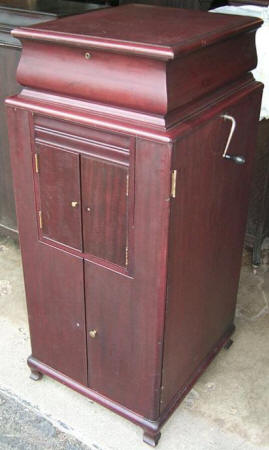 The
design of the "Victrola" began in 1904. A trial-run of this revolutionary design was
approved for production in early 1906. At that time, the Victor Talking Machine Company did not
have adequate woodworking facilities to produce full-size floor-model cabinets;
their product line consisted only of small 'table-top' models with large
external horns. The launch of this novel and expensive "Victrola" product was considered
to be a risky proposition, so the company did not want to tool-up their limited
(and overtaxed) production facilities to manufacture large wood cabinets without
knowing how the public would accept the idea. To minimize their
financial risks, they contracted with the Pooley Furniture Company of
Philadelphia (who had plenty of production capacity to produce large cabinets)
to manufacture a limited run of mahogany Victrola cabinets using Victor's
recently-patented internal-horn design. A batch of approximately 500 cabinets
was ordered in the early summer of 1906. The completed cabinets were then
shipped to Victor's factory, where the mechanical components from their best
external-horn model, the
Victor VI, were installed. This included the well-regarded triple-spring
motor and Exhibition Soundbox, with gold plated hardware.
The
design of the "Victrola" began in 1904. A trial-run of this revolutionary design was
approved for production in early 1906. At that time, the Victor Talking Machine Company did not
have adequate woodworking facilities to produce full-size floor-model cabinets;
their product line consisted only of small 'table-top' models with large
external horns. The launch of this novel and expensive "Victrola" product was considered
to be a risky proposition, so the company did not want to tool-up their limited
(and overtaxed) production facilities to manufacture large wood cabinets without
knowing how the public would accept the idea. To minimize their
financial risks, they contracted with the Pooley Furniture Company of
Philadelphia (who had plenty of production capacity to produce large cabinets)
to manufacture a limited run of mahogany Victrola cabinets using Victor's
recently-patented internal-horn design. A batch of approximately 500 cabinets
was ordered in the early summer of 1906. The completed cabinets were then
shipped to Victor's factory, where the mechanical components from their best
external-horn model, the
Victor VI, were installed. This included the well-regarded triple-spring
motor and Exhibition Soundbox, with gold plated hardware.
The new product then underwent a well-publicized launch to the
buying public in August 1906, and was an immediate success. Even with a
mind-bending price
tag of $200.00 (at a time when the average annual income was $450.00, every early-production machine was sold by the end of the year. Victor quickly realized that it
had a very profitable new product on its hands, and immediately ordered more
cabinets from Pooley. In addition, they began tooling-up their own
cabinet-making facilities to produce this product in their own plant.
The early "Pooley" cabinets had an unusual curved top section, "L" shaped
storage doors and a flat lid. Several minor hardware changes were made as
production ramped-up. Early versions had a drawer to store needles and other
small items. During the first few months of production, the crank eschuteon was
moved slightly rearward, and the lid-holding hinge changed from an 'elbow' to a
'ratchet' design. The flat-lid cabinet design (see
History of the Victrola) made access to the turntable rather inconvenient,
as the user had to 'reach-down' into the opening to change records or needles.
Production serialization of these early models began at '501', however, at least
one prototype version has turned-up a lower serial number.
Production of this model continued into the summer of 1907, when the second
iteration of the cabinet appeared. It is estimated that approximately 1,700 of
these machines were produced. The last machine of this design that was produced
was serial number 2198.
Iteration Two:
Domed Lid Filigree Cabinet (1907-1909) "VTLA" tag
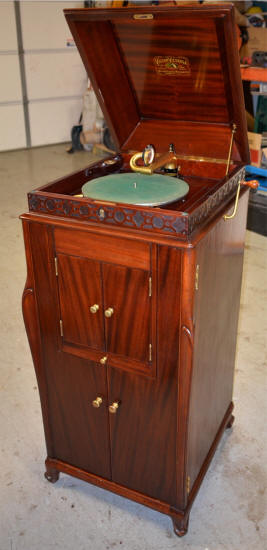 The
great success of the "Pooley" models (above) prompted Victor to make some design
improvements. The lid was modified into a domed-shape, allowing the motorboard
to be moved upward in the cabinet, allowing easier access to the turntable and
controls. The awkward lid support arm was improved, and a 'filigree'
of circle-diamond trim around the top of the cabinet was added. Product demand
remained very strong, and Victor continued to ramp-up large-cabinet production capabilities
at their Camden plant. Since they
were not yet capable of producing as many cabinets as were needed, the Pooley
Furniture Company remained under contract during 1907 and into the early months
of 1908 to manufacture these products in parallel with Victor. Pooley-built
cabinets from this time period can be identified by either a tag or stenciling
located inside the record storage area; Victor-built cabinets have no Pooley markings. A
variety of new finishes were now being offered, including oak and special-order variations
in some very exotic choices (see the FINISHES page for more information).
The
great success of the "Pooley" models (above) prompted Victor to make some design
improvements. The lid was modified into a domed-shape, allowing the motorboard
to be moved upward in the cabinet, allowing easier access to the turntable and
controls. The awkward lid support arm was improved, and a 'filigree'
of circle-diamond trim around the top of the cabinet was added. Product demand
remained very strong, and Victor continued to ramp-up large-cabinet production capabilities
at their Camden plant. Since they
were not yet capable of producing as many cabinets as were needed, the Pooley
Furniture Company remained under contract during 1907 and into the early months
of 1908 to manufacture these products in parallel with Victor. Pooley-built
cabinets from this time period can be identified by either a tag or stenciling
located inside the record storage area; Victor-built cabinets have no Pooley markings. A
variety of new finishes were now being offered, including oak and special-order variations
in some very exotic choices (see the FINISHES page for more information).
By the spring of 1908, Victor's cabinet production had expanded such
that the services of Pooley were no longer needed.
An "A" suffix was later added to indicate minor changes to the motor.
Iteration Three:
VV-XX Fancy Trim, Diagonal Pattern on Front Doors. (1908-1909) "VTLA" tag
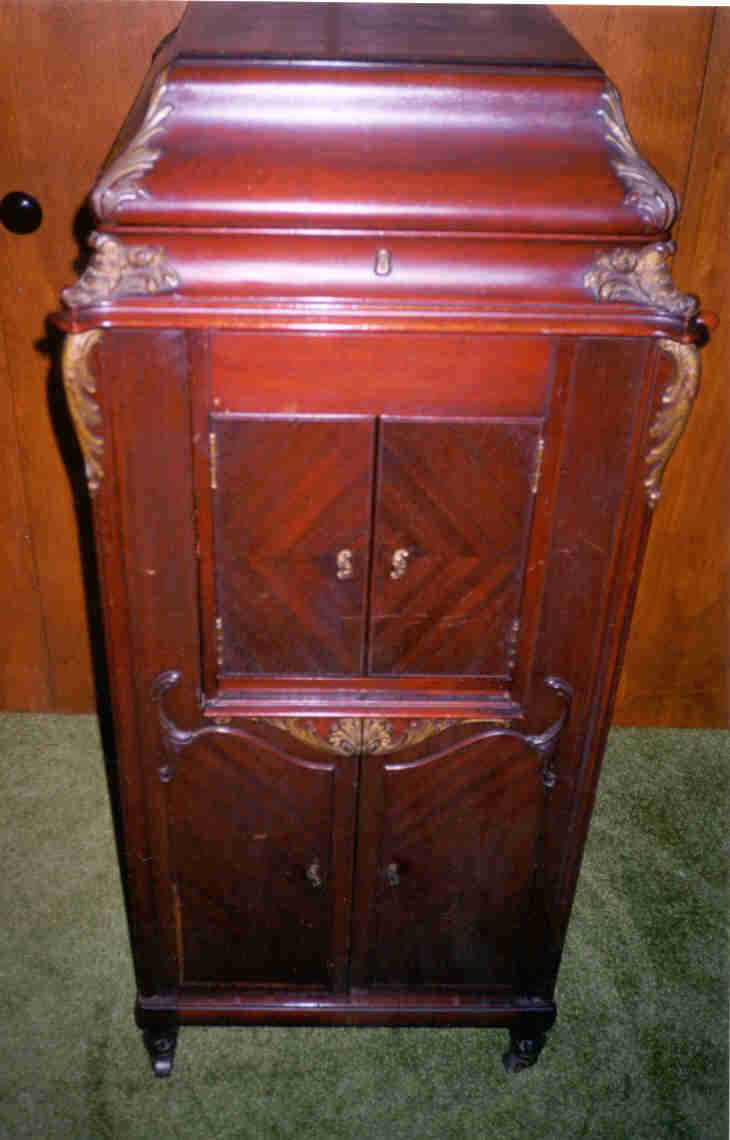 The
continuing success of the elegant and expensive early Victrolas prompted Victor
to introduce an even more prestigious machine, advertised as the "VV-XX"
or Victrola the Twentieth. Introduced in early 1908,
these machines were basically an upgrade of the standard VTLA models, with the
addition of premium veneers, a gracefully shaped lid, ornate carvings, and the
application of optional gold 'gilding' on the trim. These models sold for
an incredible price of $300.00, which equates to over $8,600.00 in today's
money. Interestingly, Victor did not include any type of model differentiator
for this exclusive product on the stamped ID dataplates, which still read
"VTLA". The only references to the "VV-XX" designation appears in published
advertising and dealer brochures; therefore, serial numbers for the XX were intermixed
with standard VTLA production machines. Based on surviving examples, VV-XX style
machines begin to appear around serial number 4500 and run as high as 8655, but
many standard VTLA machines also appear within this range.
The
continuing success of the elegant and expensive early Victrolas prompted Victor
to introduce an even more prestigious machine, advertised as the "VV-XX"
or Victrola the Twentieth. Introduced in early 1908,
these machines were basically an upgrade of the standard VTLA models, with the
addition of premium veneers, a gracefully shaped lid, ornate carvings, and the
application of optional gold 'gilding' on the trim. These models sold for
an incredible price of $300.00, which equates to over $8,600.00 in today's
money. Interestingly, Victor did not include any type of model differentiator
for this exclusive product on the stamped ID dataplates, which still read
"VTLA". The only references to the "VV-XX" designation appears in published
advertising and dealer brochures; therefore, serial numbers for the XX were intermixed
with standard VTLA production machines. Based on surviving examples, VV-XX style
machines begin to appear around serial number 4500 and run as high as 8655, but
many standard VTLA machines also appear within this range.
Production volumes for these models have been estimated at around 500 units.
Ultimately, they were either priced too high for the marketplace or were
perceived as being too gaudy, as sales never caught-on with wealthy buyers.
After a $50.00 reduction in price, the VV-XX was quietly discontinued less than
one year later. These rare machines are considered to be highly collectible
today.
Iteration Four:
Domed Lid Filigree Cabinet (1909) "XVI" tag
 In
the summer of 1909, around
serial number 12600, the "VTLA" stamped dataplate was changed to reflect the advertised
name of the product, the "VV-XVI" or "Victor-Victrola
the Sixteenth". The cabinet remained unchanged from the previous
VTLA design (above) for a few more months until the design was again updated.
Approximately 11,500 'filigree' Victrolas were produced between 1907 and 1909, including those denoted
as "VTLA" (above). These machines all have an "A" suffix after the serial
number.
In
the summer of 1909, around
serial number 12600, the "VTLA" stamped dataplate was changed to reflect the advertised
name of the product, the "VV-XVI" or "Victor-Victrola
the Sixteenth". The cabinet remained unchanged from the previous
VTLA design (above) for a few more months until the design was again updated.
Approximately 11,500 'filigree' Victrolas were produced between 1907 and 1909, including those denoted
as "VTLA" (above). These machines all have an "A" suffix after the serial
number.
Iteration Five:
L-Door Cabinet (1909-1912) "XVI" tag
By
the summer of 1909, the new Victrola was selling at a tremendous pace and
provided immense profit for the company. A new cabinet design was then
introduced, which was larger than the previous model; the filigree trim was
eliminated, and ornate hand-carved corner posts appeared. This update was also
denoted by a "B" suffix after the serial number. Small continuing improvements to the motor and hardware were made, and these
incremental changes were indicated by the inclusion of a "C" or "D" suffix on
the dataplate. The "C" version utilized a
new turntable brake
system, with a small 'tab' appearing under the platter which could be moved
to the "brake" or "free" position (replacing the previous 'barrel brake' which
had been used on all external horn Victors for years). The under-lid decal was also
changed at the transition from "B" to "C" from "Victor-Victrola" to just "Victrola" (see decals
page).
The crank position changed slightly with the "D" series.
Approximately
47,000 of these machines were made between the summer of 1909 and the fall of
1912, when yet another updated cabinet was introduced.
As a side note, Victor began introducing lower-priced Victrola models
incorporating the internal horn design to the buying public beginning in 1909. These new offerings
made Victrolas affordable to just about everyone. Thus, the XVI was no longer
the 'exclusive' machine that offered this inside-horn feature; yet it continued
in its well-established position as the company's flagship model.
Iteration Six:
Conventional Doors (1912-1914) "XVI" tag
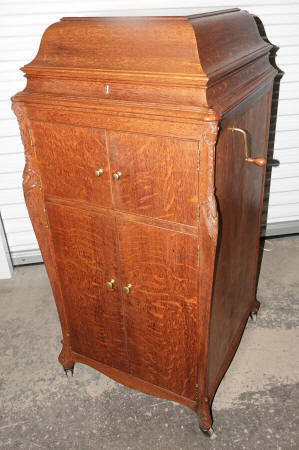 In
mid-1912, an entirely new cabinet style premiered. The overall size was again
increased and the unusual "L-Doors" were eliminated, being replaced by
conventional rectangular openings. The previous open-horn design was updated with
the use of 'slats' at the horn opening, which were intended to improve the sound
directivity. Extensive hand carvings were used on the corner posts. Suffix
letters of "E", "F" or "G" were used to indicate minor changes and updates to
the motor and hardware configurations. The "F" series was the first
Victrola to use the 'semi-automatic
brake' system. Speed controls and locations also changed with these
successive models. Approximately 40,000 XVI machines
in this configuration were produced between 1912 and 1914. The most successful year for the VV-XVI was
recorded in 1913, with over 21,000 units produced. The XVI would never again
achieve that level of annual sales.
In
mid-1912, an entirely new cabinet style premiered. The overall size was again
increased and the unusual "L-Doors" were eliminated, being replaced by
conventional rectangular openings. The previous open-horn design was updated with
the use of 'slats' at the horn opening, which were intended to improve the sound
directivity. Extensive hand carvings were used on the corner posts. Suffix
letters of "E", "F" or "G" were used to indicate minor changes and updates to
the motor and hardware configurations. The "F" series was the first
Victrola to use the 'semi-automatic
brake' system. Speed controls and locations also changed with these
successive models. Approximately 40,000 XVI machines
in this configuration were produced between 1912 and 1914. The most successful year for the VV-XVI was
recorded in 1913, with over 21,000 units produced. The XVI would never again
achieve that level of annual sales.
Iteration Seven:
Conventional Doors (1914-1920) "XVI" tag
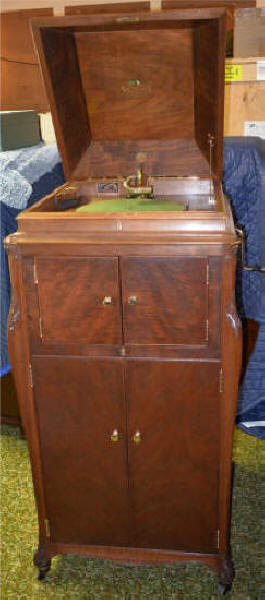 In
the final days of 1914, the XVI underwent a cost-cutting production change; the amount of
hand-carved details on the corner posts were significantly reduced while the
cabinet also became smaller. At the same time, the motor was improved via the
use of a newly-designed and more powerful 4-spring motor, replacing the
long-standing 3-spring design. These machines had an "H" suffix (or no suffix at
all). The "Exhibition" soundbox was replaced with the new "Victrola No.2"
soundbox late in 1917, and the tonearm diameter was increased. Approximately
74,000 XVI models of this style were produced between 1914 and 1920.
In
the final days of 1914, the XVI underwent a cost-cutting production change; the amount of
hand-carved details on the corner posts were significantly reduced while the
cabinet also became smaller. At the same time, the motor was improved via the
use of a newly-designed and more powerful 4-spring motor, replacing the
long-standing 3-spring design. These machines had an "H" suffix (or no suffix at
all). The "Exhibition" soundbox was replaced with the new "Victrola No.2"
soundbox late in 1917, and the tonearm diameter was increased. Approximately
74,000 XVI models of this style were produced between 1914 and 1920.
Iteration Eight:
Conventional Doors (1920-1921) "XVI" tag
In
the summer of 1920, Victrola sales were beginning to wane; phonographs had become quite commonplace in most homes,
and were no longer considered a 'status symbol'. As a
result, sales of the more expensive models (such as the VV-XVI) were the first
ones to experience a significant decline. In response, the company updated the
cabinet designs in an attempt to improve sales. While the mechanical elements
remained about the same as the previous series, the styling was streamlined and
modernized, particularly on the sweeping corner posts (which now featured
minimal hand-carved details). By this time, the price of the VV-XVI had
risen to $250.00. These machines had no suffix letters on the dataplate.
Approximately 14,700 models of this style were produced between 1920 and 1921. The XVI was officially
discontinued one year later and was replaced by the VV-120,
which was only a model ID change. The short-lived VV-120 was
identical to the XVI in all respects.
Electrola Models:
Conventional Doors (1913-1921) "VE-XVI" tag
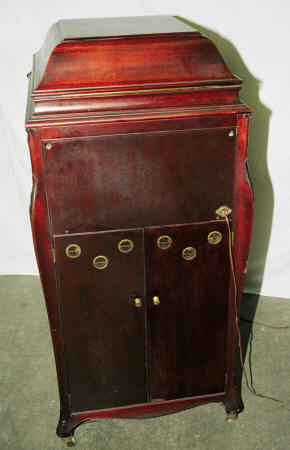 The
XVI models were the first Victrolas to offer an optional electric motor,
beginning in the fall of 1913; this was designated by a "VE" on the dataplate,
and often had an additional plate attached showing the allowable operating
voltage range. The electric motor was an expensive $50.00 option, and the motors
would operate on either AC or DC power. This electric motor feature
eliminated the need to hand-wind the motor between records. Since electric power
was available only in a very limited number of homes at that time, sales of
these models were initially slow; however, within 5 years, many more homes had
electricity, and the VE machines became increasingly popular. VE models can
always be identified by the presence of cooling vents in the back of the machine
(left) which were placed there to allow heat dissipation from the
voltage-dropping resistors mounted in the back of the cabinet, since these early
motors operated at 32 volts. Approximately 15,500 VE-XVI machines were produced
over the course of 8 years. Earliest versions had no lamp under the lid. After
the VE-XVI Type A ("A" suffix after the serial number) was introduced in April
1915, an automatic turntable light would turn on when the lid was opened. The
last versions of this model utilized the larger Victrola No. 2 soundbox. The VE-XVI was officially discontinued one year
later and was replaced by the VE-120, which was only a
model ID change. The short-lived VE-120 was identical to the VE-XVI in all
respects. When new, most owners had to use a lamp fixture (with a suitable plug
adapter) to power the motor, as electrical power outlets did not come into
common use until the 1920's. Note: many sequences in serial numbers were skipped (not
used) during production of the VE models.
The
XVI models were the first Victrolas to offer an optional electric motor,
beginning in the fall of 1913; this was designated by a "VE" on the dataplate,
and often had an additional plate attached showing the allowable operating
voltage range. The electric motor was an expensive $50.00 option, and the motors
would operate on either AC or DC power. This electric motor feature
eliminated the need to hand-wind the motor between records. Since electric power
was available only in a very limited number of homes at that time, sales of
these models were initially slow; however, within 5 years, many more homes had
electricity, and the VE machines became increasingly popular. VE models can
always be identified by the presence of cooling vents in the back of the machine
(left) which were placed there to allow heat dissipation from the
voltage-dropping resistors mounted in the back of the cabinet, since these early
motors operated at 32 volts. Approximately 15,500 VE-XVI machines were produced
over the course of 8 years. Earliest versions had no lamp under the lid. After
the VE-XVI Type A ("A" suffix after the serial number) was introduced in April
1915, an automatic turntable light would turn on when the lid was opened. The
last versions of this model utilized the larger Victrola No. 2 soundbox. The VE-XVI was officially discontinued one year
later and was replaced by the VE-120, which was only a
model ID change. The short-lived VE-120 was identical to the VE-XVI in all
respects. When new, most owners had to use a lamp fixture (with a suitable plug
adapter) to power the motor, as electrical power outlets did not come into
common use until the 1920's. Note: many sequences in serial numbers were skipped (not
used) during production of the VE models.
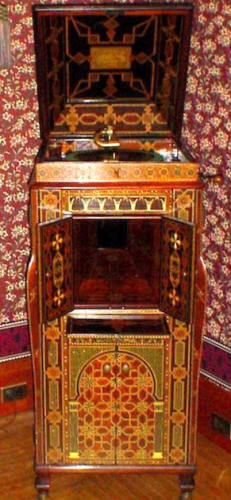 Optional
Finishes:
Optional
Finishes:
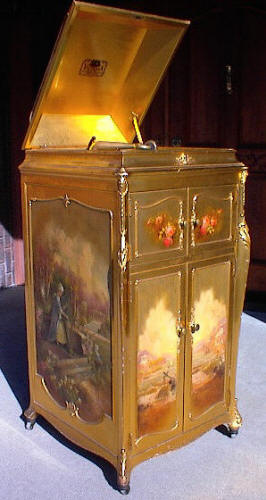 During
its long production run, XVI models could be purchased in a variety of optional
finishes, some costing hundreds of dollars above the list price of a standard
model. The most commonly chosen extra-cost finish was walnut, which added $50.00
to the list price. Initially, only Circassian Walnut was offered, but American
Walnut also became available after 1918 (see the
finish pages for more information).
Other extra-cost finish options included the "Vernis Martin" style ($400.00),
with gold leaf covering the cabinet and hand-painted images (left) or
even an exotic "Moorish Marquetry" design (right) including silver and
mother-of-pearl inlays ($750.00). Victor would produce almost any type of finish
desired on a custom-order basis, and machines with exotic woods and exquisite
paintings could be made per customer requirements. It should also be noted that
many companies would provide aftermarket 'upgrades' to these machines, including
paintings, special finish coatings and ornate designs.
During
its long production run, XVI models could be purchased in a variety of optional
finishes, some costing hundreds of dollars above the list price of a standard
model. The most commonly chosen extra-cost finish was walnut, which added $50.00
to the list price. Initially, only Circassian Walnut was offered, but American
Walnut also became available after 1918 (see the
finish pages for more information).
Other extra-cost finish options included the "Vernis Martin" style ($400.00),
with gold leaf covering the cabinet and hand-painted images (left) or
even an exotic "Moorish Marquetry" design (right) including silver and
mother-of-pearl inlays ($750.00). Victor would produce almost any type of finish
desired on a custom-order basis, and machines with exotic woods and exquisite
paintings could be made per customer requirements. It should also be noted that
many companies would provide aftermarket 'upgrades' to these machines, including
paintings, special finish coatings and ornate designs.
The survival database
currently shows the earliest existent VV-XVI to be S/N 499 (a prototype) and the
latest to be S/N 196887
The earliest logged VE-XVI survivor is S/N 501 and the latest is S/N 16064*
* Note: many sequences in serial numbers were
skipped during "VE" production. Consequently, the highest s/n and total
production output will not match for these models
| Manufacture Date | Approximate Serial Number Range | Feature Notes |
| 1906 | 501-1000 | Flat-lid Pooley-built models. Actual starting s/n is unknown. |
| 1907 | 1001-4500 | Domed lid introduced around S/N 2200 |
| 1908 | 4501-8360 | XX model introduced around S/N 4500. XX models are interspersed with VTLA model serialization |
| 1909 | 7873-17500 | VTLA designation dropped and "A" suffix added around S/N 12600. Carving under lid discontinued and "B" suffix added around S/N 13700. |
| 1910 | 17501-31400 | C suffix added at S/N 17960 |
| 1911 | 31401-52700 | D suffix added at S/N 43500 |
| 1912 | 52701-67900 | New cabinet design and E suffix added at S/N 60727. |
| 1913 | 67901-99400 | Semi-auto brake added at s/n 72076. Exposed speed indicator (on some examples) and "F" suffix added at S/N 84608. "G" suffix starts around s/n 88800. |
| 1914 | 99401-107550 | All models with G suffix. Large glass speed control added at s/n 104300. |
| 1915 | 107551-123250 | G suffix early. H suffix added at S/N 108200 |
| 1916 | 123251-139200 | All models with H suffix. A few machines have been documented with an "XVI-A" model identification tag around s/n 137000. |
| 1917 | 139201-154000 | Fat tone arm, small glass speed indicator added and serial number suffix letters dropped at S/N 143350. Victrola "No. 2" soundbox included late in year |
| 1918 | 154101-164200 | |
| 1919 | 164201-174050 | |
| 1920 | 173600-191300 | |
| 1921 | 191301-197590 | |
| VE-XVI Electric | ||
| 1913 | 501-707 | |
| 1914 | 707-3000 | Possible that serial numbers between 3000 and 3100 were never used |
| 1915 | 3100-?? | "A" suffix used after serial number 3101. S/N was 3101 produced in early 1915 |
| 1916 | Unknown | S/N 5057 was produced in late 1916. S/N's 5101 through 8000 may have been skipped in production. |
| 1917 | Unknown | S/N 10500 produced in 1917. Many groups of serial numbers were skipped in production. |
| 1918 | Unknown | |
| 1919 | Unknown | |
| 1920 | Unknown | |
| 1921 | Unknown | Last documented survivor s/n is 16064 |
Do you own a Victrola VV-VTLA/XVI? Please take a moment and enter some basic information about your machine into the collector's database by clicking here. No personal information is required.